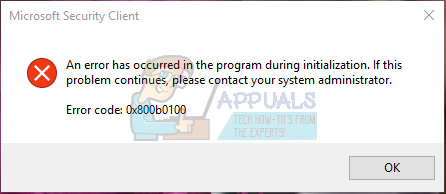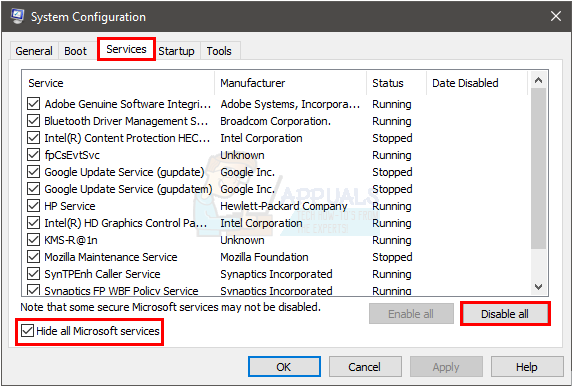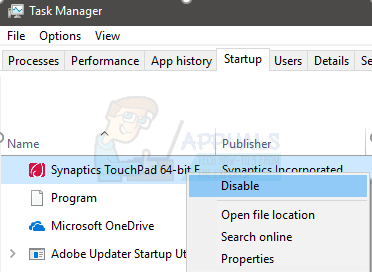Fix: Windows Defender Error Code 0x800b0100
When starting Windows Defender, you might see an error with the error code 0x800b0100. This error will prevent you from turning on Windows Defender and your Windows Defender will remain turned off.
The error 0x800b0100 can be caused by many things. It can appear because your system is infected or there might be an antivirus causing this issue or it might be because of corrupt system files. Since there can be multiple reasons, there are also various solutions available for this problem. Any method can work for you depending on the cause of the error so try each method that is given below until the problem is solved.

Method 1: Clean Boot
Clean boot will help you start your Windows with minimalistic features which means it can help you check whether the problem is because of any third party application or not. If the Windows Defender starts working properly when you clean boot, this means the error was because of some third party application.
- Hold Windows key and press R
- Type msconfig and press Enter
- Select Services tab
- Check the option that says Hide All Microsoft Services
- Click Disable All

- Click Startup tab
- Click Task Manager
- Right click on one of those items that appeared in the Task Manager and select Disable

- Repeat step 8 for every item in the Startup tab
- Close Task Manager
- Select Ok in the System Configuration window
- Restart your computer
Once the reboot is complete, try to run the Windows Defender again to check if the problem is still there. If the problem is solved then that means a third party application was interfering with the Windows Defender. The most likely application can be any other antivirus. Uninstall any antivirus and then try Windows Defender again.
After you have checked the Windows Defender, you need to change the settings back to how they were in order for your computer to start normally again. To do this, follow the steps given below
- Hold Windows key and press R
- Type msconfig and press Enter
- Select General tab
- Select Normal Startup
- Click Services tab
- Uncheck the option Hide all Microsoft Services
- Click Enable All
- Click Startup tab
- Select Task Manager
- Right on each of the items (one by one) in the Task Manager and select Enable for each of them
- If you are prompted to restart, select restart. If you aren’t prompted, just simply restart your computer and it should work as it normally does
Method 2: Check Windows Defender Service
Make sure that Windows Defender services are turned on. Sometimes they might be turned off by infection or a third party application
- Hold Windows key and press R
- Type services.msc and press Enter
- Locate Windows Defender
- Double Click Windows Defender Service
- Make sure the Startup Type is Automatic and the service is in Started condition (if it’s not, you will be able to see the enabled Start button)
- Check Windows Defender Advanced Threat Protection Service and Windows Defender Network Inspection Service. Make sure these are enabled and running by repeating the Step 5. Depending on your configurations these settings might be greyed out so don’t worry. Just change if the options aren’t greyed out and aren’t set to automatic.

Once you are done, check if the Windows Defender is running. If it’s not, check if you can start Windows Defender without the error.
Method 3: Check for Infections
Sometimes your Windows Defender might be turned off because your system has been compromised. An infection might turn off your Windows Defender to make your system more vulnerable.
Go here and download Malwarebytes. Malwarebytes will help you check and fix any issues because of infection and malware. Download the Malwarebytes and install it. Then scan your computer with Malwarebytes to see if your system is infected or not.
Method 4: Run SFC scan
The problem with the Windows Defender can also be because of the corrupted system files. So you will need to run the SFC scan to find and fix any corrupted files in order to fix the issue if it’s caused by the corrupted system files.
Go here and follow this step by step guide to run the SFC scan and repair any corrupted system files.
Method 5: Run DISM
The Deployment Image Servicing and Management (DISM) is tool that can be used to fix corrupt system file. This is a built-in tool that comes preloaded in the Windows. So you don’t have to download any third party software and you can simply run the commands from cmd.
- Hold Windows Key and press X
- Select Command Prompt (Admin)
- Type dism.exe /Online /Cleanup-image /Restorehealth and press Enter.
It will take some time so wait for it. Once the command is finished running, it is advised that you should follow the method 4.
Now check and see if the Windows Defender is working or not.